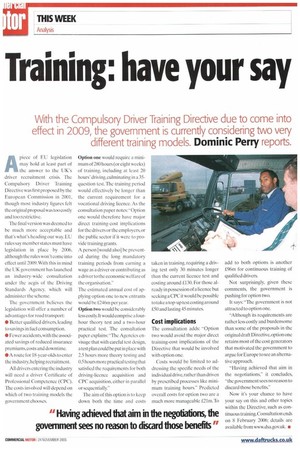Training: have your say
Page 20

If you've noticed an error in this article please click here to report it so we can fix it.
With the Compulsory Driver Training Directive due to come into effect in 2009, the government is currently considering two very different training models. Dominic Perry reports.
Apiece of EU legislation may hold at least part of the answer to the UK's driver recruitment crisis. The Compulsory Driver Training Directive was first proposed by the European Commission in 2001, though most industry figures felt the original proposal was too costly and too restrictive.
The final version was deemed to be much more acceptable and that's what's heading our way. EU rules say member states must have legislation in place by 2006, although the rules won't come into effect until 2009. With this in mind the UK government has launched an industry-wide consultation under the aegis of the Driving Standards Agency. which will administer the scheme.
The government believes the legislation will offer a number of advantages for mad transport • Better qualified drivers, leading to savings in fuel consumption.
• Fewer accidents,with the associated savings of reduced insurance premi ums, costs and downtime.
• A route for 18-year-olds to enter the industry, helping recruitment.
All drivers entering the industry will need a driver Certificate of Professional Competence (CPC). The costs involved will depend on which of two training models the government chooses. Option one would require a minimum of 280 hours (or eight weeks) of training, including at least 20 hours' driving, culminating in a 35question test. The training period would effectively be longer than the current requirement for a vocational driving licence. As the consultation paper notes: "Option one would therefore have major direct training-cost implications for the drivers or the employers,or the public sector if it were to provide training grants.
A person [would also' he prevented during the long mandatory training periods from earning a wage as a driver or contributing as a driver to the economic welfare of the organisation."
The estimated annual cost of applying option one to new entrants would be £246m per year.
Option two would be considerably less costly. It would comprise a fourhour theory test and a two-hour practical test. The consultation paper explains: "The Agencies envisage that with careful test design, a test plan could be put in place with 2.5 hours more theory testing and 0.5 hours more practical testing that satisfied the requirements for both driving-licence acquisition and CPC acquisition, either in parallel or sequentially."
The aim of this option is to keep down both the time and costs taken in training, requiring a driving test only 30 minutes longer than the current licence test and costing around £130. For those already in possession of a licence but seeking a CPC it would be possible to take a top-up test costing around £50 and lasting 45 minutes.
Cost implications
The consultation adds: "Option two would avoid the major direct training-cost implications of the Directive that would be involved with option one.
Costs would be limited to addressing the specific needs of the individual drive, rather than driven by prescribed processes like minimum training hours." Predicted overall costs for option two are a much more manageable £21m. To add to both options is another £96m for continuous training of qualified drivers.
Not surprisingly, given these comments, the government is pushing for option two.
It says: "The government is not attracted to option one.
"Although its requirements are rather less costly and burdensome than some of the proposals in the original draft Directive, option one retains most of the cost generators that motivated the government to argue for Europe to see an alternative approach.
"Having achieved that aim in the negotiations," it concludes, "the government sees no reason to discard those benefits."
Now it's your chance to have your say on this and other topics within the Directive, such as continuous training. Consultation ends on 8 February 2006; details are available from www.dsa.gov.uk.






































































































































































































